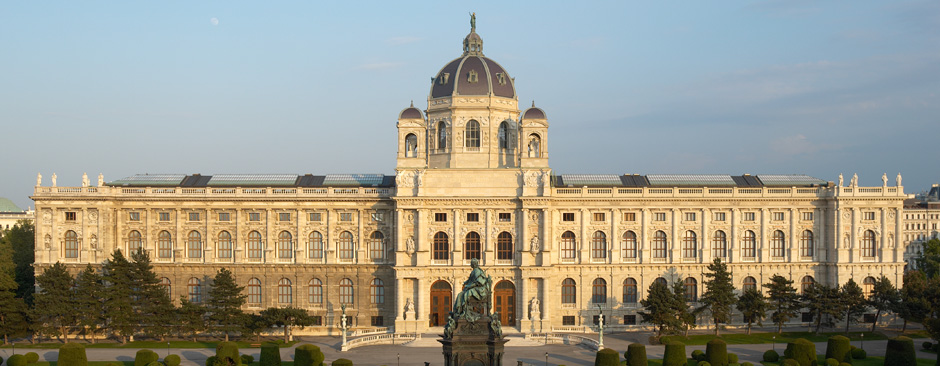The Museum
The Kunsthistorisches Museum Wien’s extensive holdings are on show at different locations:
The main building on Ringstrasse houses the Picture Gallery, Kunstkammer Wien, the Collection of Greek and Roman Antiquities, the Egyptian and Near Eastern Collection and the Coin Collection.
Other collections of the Kunsthistorisches Museum Wien are housed in the Neue Burg (i.e. the Collection of Historical Musical Instruments, the Collection of Arms and Armour, and the Ephesus Museum), in Hofburg Palace (the Treasury), and in Schönbrunn Palace (the Collection of Historical Carriages)
The collections on show at Ambras Palace in Innnsbruck are also part of the holdings of the Kunsthistorisches Museum Wien.
Since January 2001, the Weltmuseum Wien on Heldenplatz and the Theatre Museum on Lobkowitz Square have been incorporated into the Kunsthistorisches Museum Wien.

The Building
Planning of the Ringstrasse began in 1857 and included the project to bring together and show the imperial collections in a grand new building featuring state-of-the-art technical and display facilities; it took, however, another ten years until the competition to design the new museums was actually held. The architects who participated in 1867 were Hansen, Löhr, Ferstel and Hasenauer, all of whom worked in Vienna. When jury and patron failed for months to agree on a winner, Gottfried Semper, the internationally-renowned architect known for his museum designs, was called in as an advisor in 1868.
The Emperor then decided to commission Semper to alter and complete the plans initially presented by Hasenauer. But he also enlarged them – his designs were informed by urban planning in ancient Rome – to create what was known as the “imperial forum”: He envisaged an additional – also symmetrical - pair of buildings aligned with the two museums, each of which featured a semi-circular façade. These two buildings were to flank the Hofburg’s Leopoltinische Trakt (the wing of the old palace erected under Emperor Leopold) for which Semper planned a modern façade and that would house the throne room.
However, only the two museums and the part of the “Neue Burg” (new palace) facing the Burggarten (palace garden) were realised. Work on the museums commenced in 1871 and twenty years later, in 1891, they were formally opened to the public. Semper had moderated Hasenauer’s original design for the façades and they now feature a complex art-historical programme of sculptures and reliefs. The building’s internal structure combines two architectural traditions: entrance hall, staircase and cupola hall form a dramatic unit that celebrates the imperial patron and his predecessors.
An additional elegant feature is the circular opening in the ceiling of the entrance hall that offers visitors their first glimpse of the cupola hall. Ascending the stairs, visitors pass Antonio Canova’s “Theseus Slaying the Centaur” on their way to the cupola hall, the apex of imperial display. Along this central axis a wealth of neo-baroque decorations create one of the most solemn and splendid interiors of late-nineteenth-century Vienna, probably unrivalled in any other European museum.
fonte: @edisonmariotti #edisonmariotti http://www.khm.at/
Realms of Imagination
Albrecht Altdorfer and the Expressivity of Art around 1500
The exhibition focuses on one of the most striking phenomena in Renaissance art north of the Alps: the strong wave of expressive formulae permeating art created around 1500. It culminates in the work of Albrecht Altdorfer and other representatives of the Danube school such as Wolf Huber or the Master IP, but we also find similar phenomena outside Austria and Bavaria in other parts of Central Europe.



Nenhum comentário:
Postar um comentário